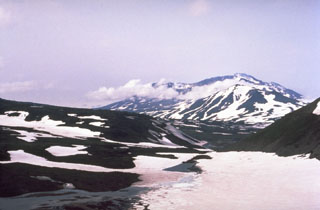Report on Gorely (Russia) — July 1980
Scientific Event Alert Network Bulletin, vol. 5, no. 7 (July 1980)
Managing Editor: David Squires.
Gorely (Russia) Explosions and crater glow
Please cite this report as:
Global Volcanism Program, 1980. Report on Gorely (Russia) (Squires, D., ed.). Scientific Event Alert Network Bulletin, 5:7. Smithsonian Institution. https://doi.org/10.5479/si.GVP.SEAN198007-300070
Gorely
Russia
52.5549°N, 158.0358°E; summit elev. 1799 m
All times are local (unless otherwise noted)
During 1978-79 large fumaroles appeared in the central crater and a lake was formed on the crater floor. In January 1980 a 1-km-high gas column was first observed over the summit. This remained throughout the spring, and gas vents appeared on the walls and floor of the crater.
In June intensive gas emission was accompanied by explosions that ejected lithic material. During this presumed phreatic eruption the crater lake disappeared. As of late July, activity was increasing and a glow was visible over the crater at night.
Further References. Gavrilov, V.A., Gordeev, E.I., and others, 1984, Volcanic tremor and the Gorely volcano earthquakes during the 1980-1981 eruption: Volcanology and Seismology, no. 6, p. 3-17.
Kirsanov, I.T., 1981, Eruption of the Gorely volcano in summer 1980: Volcanology and Seismology, no. 1, p. 70-73.
Geological Summary. Gorely volcano consists of five small overlapping stratovolcanoes constructed along a WNW-ESE line within a large 9 x 13 km caldera. The caldera formed about 38,000-40,000 years ago accompanied by the eruption of about 100 km3 of tephra. The massive complex includes about 40 cinder cones, some of which contain acid or freshwater crater lakes; three major rift zones cut the complex. Another Holocene stratovolcano is located on the SW flank. Activity during the Holocene was characterized by frequent mild-to-moderate explosive eruptions along with a half dozen episodes of major lava extrusion. Early Holocene explosive activity, along with lava flows filled in much of the caldera. Quiescent periods became longer between 6,000 and 2,000 years ago, after which the activity was mainly explosive. About 600-650 years ago intermittent strong explosions and lava flow effusion accompanied frequent eruptions. Historical eruptions have consisted of moderate Vulcanian and phreatic explosions.
Information Contacts: E. Vakin and I. Kirsanov, IVP.

